Mondo Kongo
Anyone who’s seen the Lord of the Rings trilogy (or, more to the point, has sat through the extended versions on DVD) knows Peter Jackson has never been into brevity. He couldn’t operate farther from a less-is-more aesthetic if he tried.
Eye-filling visuals, teary emotionalism, portentousness, sets and costumes that are just so, probing closeups, dialogue scenes that go on longer and are more exacting than necessary…Jackson loves to heap on the syrup.

It should therefore come as no surprise that King Kong, his latest film which Universal will open theatrically on 12.14 (or six and a half weeks from today), is going to run three hours, according to a 10.27 story by New York Times reporter Sharon Waxman.
The obvious implication is that Jackson’s Kong is going to be a lot more about Jackson — his brushstrokes, I mean, and the absolute power and perogative he has to throw as much paint at the canvas as he deems fit — than anything else.
< ?php include ('/home/hollyw9/public_html/wired'); ?>
It also seems that Jackson’s indulgent streak has most likely overwhelmed any chance of audiences getting to savor a straight, clean re-telling of a classic tale about a dishy blonde and a big heartsick ape.
Take a look at the Kong stills and it’s obvious the film is going to look awesome. They’re clearly mouth-watering. But that aside, all bets are off.
I know how some of you are reading this. I have a case against Jackson and have hated everything he’s done since Heavenly Creatures, blah blah, so anything I say in advance about King Kong is a broken-record “here we go again” deal.

Note to eagle-eyed proofreaders: the misspelling of Adrien Brody’s name above is not my doing and I can’t figure how to Photoshop in a correction.
But ask yourselves this: has there ever been a remake of any kind — play, film, televised — that has been judged to be superior because it went on longer and used more words, sets, costumes and tubes of paint than the original leaner version?
I’m not saying this hasn’t ever happened (and I will honestly love it if Jackson outdoes the original in any way…really), but I’m having trouble thinking of an example.
The whole idea in Jackson making this film, according to his own proclamations when he began work on it a couple of years ago, was to pay some kind of tribute to Merian C. Cooper’s 1933 original film. Not in a Gus Van Sant/Psycho way, but to essentially re-do a classic movie…to re-experience and re-deliver to modern audiences what he loved about Kong when he first saw it as a kid on TV.
The project, which has swollen in cost to $207 million dollars, has apparently evolved into something more obsessive than personal.
The 1933 Kong runs 100 minutes, and Jackson is pretty much using the same story and situations, or so I’ve understood all along. So what could the extra 80 minutes be about? Only a few people know, but I’m fairly certain they’re about one thing and one thing only: Jackson’s power to make this film any way he damn well pleases, and about nobody at Universal being able to say boo.
In other words, the extra 80 minutes are about the auteurist “wheee!” factor…the same carte blanche E-ticket that has allowed all powerful directors at the apex of their careers to go for broke.

Given his huge success with the Rings trilogy, Jackson is certainly in no position, contractually or psychologically, to alter his modus operandi. And he’s in no way obliged to listen to anyone else’s opinions, be they practical brass-tacks sugges- tions or what-have-you.
“The film is substantially longer than Universal had anticipated and presents dual obstacles,” Waxman writes. “The extra length has helped increase the budget by a third…while requiring the studio, owned by General Electric, to reach for the kind of long-term audience interest that made hits out of three-hour movies like Titanic and the films in Mr. Jackson’s Rings trilogy.
“Hollywood blockbusters have increasingly relied on big releases that bring in as much as half of their ticket sales on the first weekend. But long films receive far fewer showings per day, and the most successful ones, like Lord of the Rings: The Fellowship of the Ring (2001) by Mr. Jackson, which took in $315 million at the domestic box office for New Line Cinema, have remained in theaters for well over half a year.”
Asked about the length of King Kong, Universal executives told Waxman they saw it “as an advantage in an era when jaded moviegoers are hungering for something extraordinary.
“‘This is a three-hour feast of an event,’ said Marc Shmuger, vice chairman of Universal Pictures. ‘I’ve never come close to seeing an artist working at this level.'”

Waxman notes that “few elements of the film have been seen by the larger public, and even Universal executives saw a finished version of King Kong’s face — with its expressive eyes, broadly fierce nose and mane of computer-generated hair — only in recent days.”
“Expressive eyes”? Is that Waxman talking or something she was told by some other Universal exec? No telling yet, but a Golum-ish, Andy Serkis-ized Kong will be a very tough row to hoe.
“Exhibitors have long complained that very long films make it harder to draw audiences, though in this difficult year at the box office, they have complained louder about not having enough good films to show,” Waxman writes.
No one will be happier than myself if Kong kicks ass. And yet the indications are what they are. Snaggle tooth, Jack Black doing a half-comical spin on Carl Den- ham, three-hour running time, 11th-hour firing of composer Howard Shore, etc.
Talk me out of this. Tell me how I’m reading this the wrong way…I mean, without resorting to the usual you-can’t-see-straight-when-it-comes-to-Peter-Jackson argument.
Implied
That European poster for Steven Spielberg’s Munich (Universal, 12.23) confirms what I wrote about this film last March, which is that it’s not going to be about killing the Palestinian perpetrators of the 1972 Munich Olympic Games massacre as much as the feelings of guilt and futility that are the inevitable dividend of any such act.
Munich, which will star Eric Bana and Daniel Craig, is about a revenge operation planned and executed by Mossad, or Israel’s CIA. And, I gather, the moral and ethical mucky-muck that resulted. The script is by New York playwright Tony Kushner (Angels in America).
The guy in the poster is sitting in a hotel room and holding a piece and obviously experiencing a moment of spiritual doubt of some kind. He’s not wondering what TV show to watch.
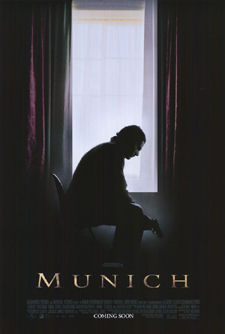
European one-sheet for Steven Spielberg’s Munich
Munich will be Spielberg’s second major-league feature having to do with lethal aggression against Jews, the first being Schindler’s List, and he knows this latest effort will be compared to his 1993 Oscar winner, so he’s got to…you know…make it complex, high-minded, morally probing.
The theme, I’m guessing, will be something along the lines of “if we all keep taking an eye for an eye, pretty soon the world will be blind.” This line comes from a 1986 TV movie called Sword of Gabriel, which was based on the same true-life story the Spielberg-Kushner film is apparently about.
Two athletes were killed during a hostage-taking and stand-off situation with German authorities at Munich’s Olympic village. Nine more were killed by a grenade blast at Munich’s Furstenfeldbruck airport when authorities tried to shoot it out with the terrorists.
I haven’t read Kushner’s script, but one of the film’s vantage points is that of “Committee X,” a high-ranking group of Israeli officials, chaired by Israeli premiere Golda Meir and Defense Minister Mosha Dayan, and the assassination campaign they ordered Mossad to carry out — to murder every strategist and supporter known to have in some way supported Black September’s Munich operation.

A member of Black September standing on balcony of Israeli athletes’ condo in Munich’s Olympic Village during September 1972 hostage stand-off.
The operation was known in some circles as Operation Wrath of God.
The idea behind the campaign, which was known as the kidon (Hebrew for bayonet) and run by senior Mossad agent Mike Harrari, was to strike terror in the hearts and minds of the plotters. It was primarily for the sake of revenge, I’m sure, but also to try and psychologically deter similar operations.
Mossad started with a list of 11 names, but the people they wound up killing numbered 18, by one count.
Harrari’s plan was to be absolutely precise and avoid collateral damage, and yet people who had nothing to do with the Munich killings — a Moroccan waiter, a Russian KGB agent, an Arab-looking bodyguard in Gibraltar, three Arab-looking guys who made the mistake of pulling out guns during a raid in Switzerland — died at the hands of the kidon killers. Seven in all.
Snob Aesthetics
My favorite flip-through book last summer was David Kamp and Steven Daly’s “The Rock Snob’s Dictionary” (Broadway Books), an incisive and tidy sum-up guide about the who, what and wherefores of elitist rock-music savoring.
And now I’m into “The Film Snob’s Dictionary,” which I scored an advance copy of last week. It’s less of an education than “Rock Snobs” — I’m obviously much more familiar with the turf — but I’m having just as good a time with the knowingness and wit and concise prose style.

“The Film Snob’s Dictionary” won’t be out until February ’06 (to tie in with seasonal Oscar frenzy), but I don’t think I’m blurbing it too early. You’ll be reading advance items and friendly mentions come November-December, and…I don’t know…time seems to whiz by faster and faster these days…torrents of information surging at hurricane-speed.
The authors are the Manhattan-based Kamp, a longtime Vanity Fair writer and sometime contributor to GQ, and another New York journo named Lawrence Levi, who first met Kamp when they worked together at Spy in…I think it was the late ’80s or early ’90s, when Graydon Carter was the editor.
Snobs are always hovering around any field of creative endeavor, and most of them are usually fringe wannabe types (i.e., producers, financial patrons, hangers-on) covering some insecurity.
Film Snobs are mostly fringe types also, but a certain number can be found among journalists and critics. Naturally, I exclude myself. I have this delusional idea that I’m an anti-snob, man-of-the-people type. The truth is that I know my stuff and feel no empathy for lowbrow ignorance, and I always go into fits when people refuse to support a film I know is intelligent, well-honed and suffused with honest emotion.
So maybe I’m a bit snobby, although for the sake of balance I try to ground myself in my middle-class, rubbing-shoulders-with-prole-types background. And I think Bollywood films are for the birds.
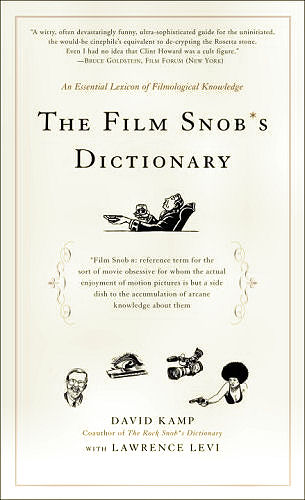
And yet I couldn’t help laughing when I read this line from the opening graph of “An Introductory Note by the Authors”:
“The Film Snob fairly revels, in fact, in the notion that The Public Is Stupid and Ineducable, which is what sets him apart from the more benevolent Film Buff — the effervescent, Scorsese-style enthusiast who delights in introducing novitiates to The Bicycle Thief and Powell-Pressburger films.”
I know film-snob attitudes quite well, or at least what it is to feel grossly insecure about not knowing enough about movies and therefore lacking the chops to qualify as a snob.
I felt this way when I first came to New York in the late ’70s to try and make it as a film journalist. I was acutely aware that I didn’t have the seasoning and the film knowledge to even stand in the same vicinity as the big New York guns of the time (Pauline Kael, Andrew Sarris, Stuart Byron, etc.), and it caused me no shortage of anguish.
This was compounded by the fact that writing articles at the time was doubly difficult because I couldn’t relax and just write what I knew and felt on my own terms.

Pauline Kael
I finally got past all this, partly out of a realization that certain elite critics lived on the planet Neptune. I came to realize that although they knew what they knew and had a brilliant way of saying it, their views weren’t any better than mine…although my respect for the elites and worshipping their prose all those years (as well as boning up on venerated critics like Andre Bazin, Otis Ferguson, Manny Farber, Dwight McDonald, James Agee, et. al.) had a cumulative effect.
I wrote last summer that I especially enjoyed “The Rock Snob’s Dictionary” because “it’s so exquisitely written. Every sentence is a Hope diamond, chiseled and honed and phrased to perfection with just the right seasoning of know-it-all attitude…aimed, naturally, at the snobs who initially created it.” The same goes with the new volume. It’s an immaculate, whip-smart read.
One difference is that “The Film Snob’s Dictionary” runs 114 pages, or 36 pages shorter than “The Rock Snob’s Dictionary.” I would have preferred a few more snob obsessions being thrown in (film snobbery encompasses a vast universe and at least 85 years of film history) …but since it’s aimed at people who don’t know this world at all, I guess the idea was to avoid getting too anal-particular.
Another difference is that knowing the film world as I do, a lot of what’s in the book is back-of-the-hand familiar. But I’m sure rock aficionados felt the same way last summer.
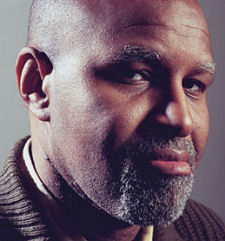
New York Press critic Armond White
The intro piece is pretty good…
“The Film Snob’s stance is one of proprietary knowingness — the pleasure he takes in movies derives not only from the sensory experience of watching them, but also from knowing more about them than you do, and from zealously guarding this knowledge from the cheesy, Julia Roberts-loving masses, who have no right whatsoever to be fluent in the works of Samuel (White Dog) Fuller and Andrei (the original Solaris) Tarkovsky.”
The graph about the public being Stupid and Ineducable follows, and then…
“The Film Snob’s Dictionary seeks to redress the knowledge gap between Snobs and non-Snobs, so that normal, nonsociopathic, movie-loving people may (a) become privy to some of the good stuff that Film Snobs zealously hoard for themselves; and (b) avoid or approach cautiously the vast quantities of iffy or downright crappy material that Snobs embrace in the name of Snobbery.
“This second service is especially valuable, because the Film Snob’s taste is willfully perverse, glorifying drecky Hong Kong martial-arts flicks and such misunderstood works of genius as Mike Judge’s Office Space and Michael Mann’s Heat for no rational reason whatsoever.”
(I read the preceding graph Sunday night to L.A. City Beat film critic Andy Klein, who isn’t a snob but surely knows his stuff as well as Jim Hoberman or Armond White. Klein laughed and said, “Obviously they’re trying to get a rise out of critics,” etc. He also declared that Heat, Office Space and, one inferred, a selection of his favorite Hong Kong chop-socky flicks “are all great.”)
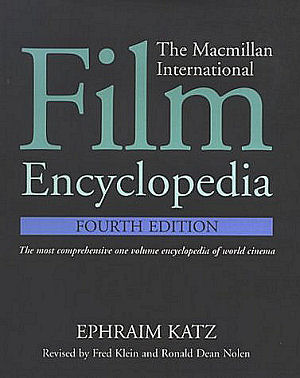
“The authors of this book, in compiling its entries, have sought to strike the right balance between intellectual curiosity and Snob madness, so that the reader will feel less intimidated about renting a genuinely entertaining film such as Fritz Lang’s M just because it is ‘German Expressionist,’ but liberated from the burden of ever having to watch a Peter Greenaway film.”
The intro also says that “readers knowledgable about film will notice the conspicuous absence from The Film Snob’s Dictionary, apart from passing references, of such titans of foreign cinema as Federico Fellini (8 1/2), Ingmar Bergman (The Seventh Seal), Akira Kurosawa (The Seven Samurai), and Satyajit Ray (the “Apu” trilogy).
“The Film Snob may indeed know a fair amount about these filmmakers (Fellini in particular, given that his movies’ soundtracks were often composed by Snob cause celebre Nino Rota), but he generally scoffs at them, deeming them to be mere name-drops for bourgeois losers wishing to seem cultured. Watching a Bergman film is so PBS tote-bag, so Mom-and-Dad-on-a-date-in-college, so baguettes-and- Chardonnay.
“The Snob prides himself on his populist, un-arty taste, favoring, for example, the soapy, over-emotive schlock of India’s Bombay-based `Bollywood’ film industry over the artful, nuanced films of the Calcutta-born Ray, and the Spaghetti Westerns of Sergio Leone and Corbucci over anything Fellini ever made. It’s a reverse Snobbery more powerful than the Snobbery it’s rebelling against.”

New York Observer critic Andrew Sarris
There are something like 250 capsule mentions. As noted earlier, there could probably be another 100 or so more if Kamp and Levi wanted to bulk up. Some of these have appeared in two past issues of Vanity Fair, and there’s a site that quoted a few of them in ’04, so it doesn’t seem like much of a spoiler to excerpt a few more.
The eight entries I’m running deal solely with critics and film magazines/sites. If it were my book I would have mentioned other Neptuners (B. Ruby Rich, Jim Hoberman, Ray Pride, Armond White, Robert Koehler, Emanuel Levy) — each of whom, it could be argued, are fascinating in their authority-exuding quirkiness.
There’s certainly no slight in saying these people should have been included. Film Snobbery is an excusable neurotic outgrowth of being an extra-passionate Film Buff, and every Neptuner I’ve mentioned in this graph is a fine writer and respected scholar, so let’s not have any arched backs.
Anyway…
Farber, Manny: Beloved alter kocker film critic emeritus, now working as a a painter in Southern California. Preceding his friend Pauline Kael by more than a decade as a nonconformist thinker about movies, Farber got his start writing reviews for The New Republic in the 1940s and proved as comfortable decon- structing Tex Avery cartoons and Don Siegel genre exercises as he was evaluating the French New Wave and Rainer Werner Fassbinder — in effect, inventing the prevailing critic vogue for high thought on low entertainment. A big influence of Snob-revered Jonathan Rosenbaum, Farber, more than Kael or Andrew Sarris, is the name to drop for instant Crit Snob credibility.
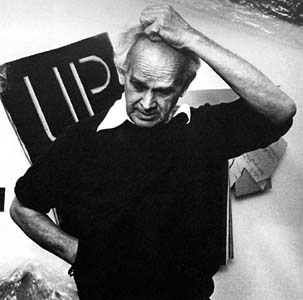
Retired film critic Manny Farber
Film Comment. Smug, aggressively elitist bimonthly magazine published by the Film Society of Lincoln Center. Where Snobs go to read (or write) dithery articles about Bollywood and despairing critiques of popular cinema.
Film Threat. Surprisingly buoyant, unsmug Web ‘zine devoed to independent film. Where Snobs go to read fulsome appreciations of Sam Raimi and interviews with such Queens of the B’s as Debbie Rochon and Tina Krause.
Katz, Ephraim. Industrious Israeli-born film nerd who, in the 1970s, single- handedly undertook the task of compiling an encyclopedia of film. Published in 1979, after years of work, Katz’s The Film Encyclopedia quickly established itself as the definitive film reference for both Snobs who need to know what a “friction head” is (it’s a kind of tripod head that ensures smooth camera movement) and laypersons who can’t keep Linda Darnell straight from Joan Blondell. Katz died in 1992, and successive, expanded editions of the Film Encyclopedia have been produced by his proteges, though hard-core Snobs take issue with some of the cuts that were made from Katz’s original, and keep the ’79 edition around.
Kael, Pauline. Revered film critic (1919-2001) whose work, most of which appeared in The New Yorker, stood out for its bracing, provocative prose and its author’s loony, nonsensical taste; no one was smarter and more cogent about Cary Grant’s career and Steve Spielberg’s early films, yet no one was more reckless in overpraising grim 1970s murk and unbearably blowsy female performances (e.g., Elizabeth Taylor in X, Y & Zee; Karen Black in Come Back to the 5 & Dime, Jimmy Dean, Jimmy Dean; Bette Midler in Big Business). A tiny woman, Kael nevertheless inspired fear in her legions of movie-critic acolytes (known as “Paulettes”), full-grown men and women who tremulously sought her unforthcoming approval and pilgrimaged to her home in the Berkshires in the vain hope of being anointed her heir apparent.
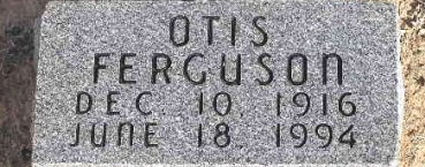
Kehr, Dave. Third- or possibly fourth-string New York Times movie critic. Though often relegated to reviewing DVD releases, he is preferred by Snobs over A.O. Scott, Manohla Dargis and Stephen Holden.
Rosenbaum, Jonathan. Industrious but mirthless film critic for the Chicago Reader; one of the few important film writers of the post-Kael era. Given to chiding fellow Snobs about their ignorance of the Iranian New Wave.
Sarris, Andrew. Brooklyn-born film critic and theorist known for popularizing the Auteur Theory, and for arousing the ire of Pauline Kael with his totemic 1968 book The American Cinema: Directors and Directions, 1929 — 1968, in which he categorized directors by preference, prompting Kael to deride him, to his face, as a “list queen.” His gentlemanly, hypeless prose has remained consistent since 1960, when he began writing for the Village Voice. Married to the fellow film-critster Molly Haskell, Sarris now plies his trade for the New York Observer and as a trainee Snob-admired lecturer at Columbia University.
Reminder to Kamp and Levi: Montgomery Clift got drunk and slammed his car into that telephone pole in May, 1956. And the cool thing about Todd A-O in the 1950s wasn’t just the 70mm format — it was mainly the 30-frame-per-second rate of photography and projection (even though it was viewable in the big-city roadshow engagements of only two films — Oklahoma! and Around the World in 80 Days).
“The Film Snob’s Dictonary” is an essential, highly educational read for non- snobs, and snobs will have to buy a copy just to keep it on their bookshelves… something to leaf through and reflect upon as a kind of cautionary text.

Montgomery Clift
Grabs

Lounge area on main floor of Algonquin Hotel — Monday, 10.24.05, 10:30 pm.
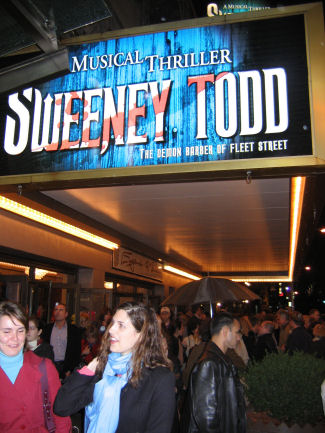
Tuesday, 10.25, 10:25 pm.

Marilyn Monroe photo shoot, sometime around ’59 or ’60. (I think.)












